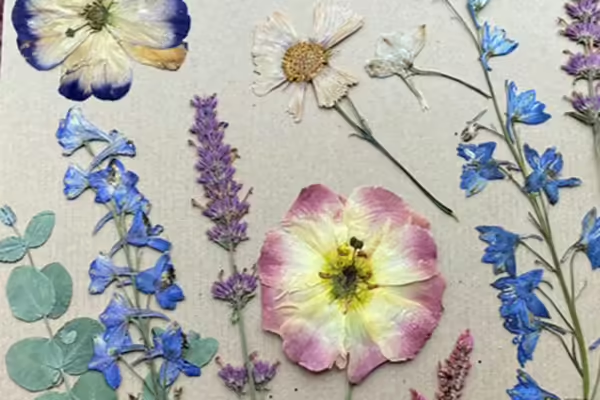
URBANA, Ill. — A great way to enjoy flowers with family and friends is to harvest and preserve them. The popularity of dried and pressed flowers has turned an old hobby into a renewed interior design and art trend. Who has not pressed that lucky four-leaf clover between a couple of pages of a book?
Flowers chosen should be harvested and prepared so that they hold their color and form. These types are called everlasting flowers as they dry out very easily.
Everlasting flowers are composed of colorful, papery petals or bract-style modified leaves that, when mature, are stiff and dry when still attached to the living plant. Planting annuals and perennial flowers that are suitable for drying extends gardening activities without elaborate equipment or previous experience for the whole family to enjoy.
Types of everlasting flowers
Some plants and flowers that are suitable for air drying include larkspur (Consolida ajacis), strawflower (Bracteantha bracteate), statice (Limonium sinuatum), globe amaranth (Gomphrena globosa), love in the mist (Nigella damascena), yarrow (Achillea species), money plant (Lunaria annua), blazing star (Liatris spicata), and millet (Setaria italica). Ornamental grasses are another option that adds an airy, whimsical element of what lies beyond the stems or seed heads.
Tips for harvesting flowers for drying
Harvest flowers that are close to prime. Flowers to be air-dried continue to open as they dry, so they should not be fully open when picked. Poor shapes dry as poor shapes. The best time to pick is on a sunny afternoon when plant parts contain the least amount of moisture. Harvest flowers just before they have fully opened since they will continue to mature after they have been cut. Remember, do not harvest flowers that have already wilted, as they will not hold shape. When picking, strip the foliage from the stem by holding the stem just below the bloom and running your hand down the stem to
remove foliage. This will prepare the flower stem for gathering and bundling prior
to drying.
Tips for drying flowers
Air-drying is the easiest and most common way to preserve most flowers. Stems dried in this process will be fairly straight.
- Cut flowers of good quality in prime condition
- Remove foliage from stems
- Gather the stems into small bunches and bind them with a rubber band or twist tie instead of a string, as the bunches shrink as they dry.
- Hang the bunches upside-down in a warm, dry, dark area with good air circulation. Avoid direct sunlight that will fade the flowers.
- Attach the tied bunches with a paper clip to the drying rack, line, or nail.
- Allow hanging until thoroughly dried, which generally takes two to three weeks.
A few large flowers, such as peonies and hydrangea, are sometimes dried in this way but should be hung individually. Going one step further with this activity, you can make dried arrangements or posies. Remember, flowers dried in this manner are extremely stiff once dried, and some flowers shrink like roses and peonies. Blue and yellow flowers retain their colors when air-dried, but pink flowers tend to fade. This drying method is still an inexpensive and fun activity for any age to enjoy.
Examples of drying using desiccants or substances used to create dryness may include the process of borax combined with sand or cornmeal, silica gel, oolitic sand, standard sand, microwave oven drying, freeze-drying, water drying, or preserving foliage with glycerin. What method will you try? Remember that each method should be researched before attempting so that proper precautions can be taken.
The last method for everlasting flowers would be to press plant material or flowers. Pressing requires sandwiching flowers and foliage between layers of absorbent material. One way is between the pages of a book, which is closed and weighted down. Wooden presses can also be used with bolts and wing nuts to apply pressure to absorbent material for drying. Finally, heat pressing can be done with a warm iron and wax paper. In comparison, microwave ceramic tiles and paper towels can be used for a quick heat press.
Pressing flowers is a trendy way to preserve flowers from special occasions that can be arranged in framed displays or as artwork. Use everlasting flowers to create everlasting memories.
For more information on cut flower gardening activities, connect with your local Extension office at go.illinois.edu/ExtensionOffice.
WRITER: Christina Lueking is an Illinois Extension horticulture educator for Bond, Clinton, Jefferson, Marion, and Washington counties. Gardeners Corner is a quarterly newsletter from gardening experts around the state. Each issue highlights best practices that will make your houseplants, landscape, or garden shine in any season. Join the Gardener’s Corner email list at go.illinois.edu/GCsubscribe for direct access to timely tips.
PHOTO ACCESS: The photo in this article is available to download for media use. Photo by Christina Lueking.
Illinois Extension leads public outreach for University of Illinois by translating research into action plans that allow Illinois families, businesses, and community leaders to solve problems, make informed decisions, and adapt to changes and opportunities. Illinois Extension is part of the University of Illinois Urbana-Champaign College of Agricultural, Consumer and Environmental Sciences.